

The Queen Anne style of furniture design developed before, during, and after the time of Queen Anne, who reigned from 1702 to 1714. [1]


The Queen Anne style of furniture design developed before, during, and after the time of Queen Anne, who reigned from 1702 to 1714. [1]
Queen Anne furniture is "somewhat smaller, lighter, and more comfortable than its predecessors," and examples in common use include "curving shapes, the cabriole leg, cushioned seats, wing-back chairs, and practical secretary desk-bookcase pieces." [2] Other elements characterizing the style include pad feet and "an emphasis on line and form rather than ornament." [3] The style of Queen Anne's reign is sometimes described as late Baroque rather than "Queen Anne." [4] [5]
The Queen Anne style began to evolve during the reign of William III of England (1689-1702), [6] but the term predominantly describes decorative styles from the mid-1720s to around 1760, although Queen Anne reigned earlier (1702-1714). [4] [7] "The name 'Queen Anne' was first applied to the style more than a century after it was fashionable." [5] The use of Queen Anne styles in America, beginning in the 1720s and 1730s, coincided with new colonial prosperity and increased immigration of skilled British craftsmen to the colonies. [8] [9] [10] Some elements of the Queen Anne style remain popular in modern furniture production. [5]

Curved lines, in feet, legs, arms, crest rails, and pediments, along with restrained ornament (often in a shell shape) emphasizing the material, are characteristic of Queen Anne style. [5] In contrast to William and Mary furniture, which was marked by rectilinearity (straight lines) and use of curves for decoration, Queen Anne furniture uses C-scroll, S-scrolls, and ogee (S-curve) shapes in the structure of the furniture itself. [5] In sophisticated urban environments, walnut was a frequent choice for furniture in the Queen Anne style, [5] superseding the previously dominant oak and leading to the era being called "the age of walnut." [6] However, poplar, cherry, and maple were also used in Queen Anne style furniture. [11]

Ornamentation is minimal, in contrast to earlier 17th-century and William and Mary styles, which prominently featured inlay, figured veneers, paint, and carving. The cabriole leg is the "most recognizable element" of Queen Anne furniture. [12] [6] Cabriole legs were influenced by the designs of the French cabinetmaker André-Charles Boulle [13] and the Rococo style from the French court of Louis XV. [14] But the intricate ornamentation of post-Restoration furniture was abandoned in favor of more conservative designs, possibly under the influence of the simple and elegant lines of imported Chinese furniture. [13]
When decorative motifs or other ornamentation are used in Queen Anne-style furniture, it is often limited to carved scallop or shell or scroll-shaped motifs (sometimes in relief form and often found on the crest and knees), [5] broken and C-curves, and acanthus leaves. [15] The use of japanning is an exception to the general Queen Anne trend of minimal ornament. [5] When used, japanned decoration was frequently in red, green, or gilt on a blue-green field. [11]
The tilt-top tea table on a tripod was first made during the "Queen Anne" (in reality George II) period in the 1730s. [16]
Queen Anne eventually was eclipsed by the later Chippendale style; late Queen Anne and early Chippendale pieces are very similar, and the two styles are often identified with each together. [17] [18] [19]

Rococo, less commonly Roccoco, also known as Late Baroque, is an exceptionally ornamental and dramatic style of architecture, art and decoration which combines asymmetry, scrolling curves, gilding, white and pastel colours, sculpted moulding, and trompe-l'œil frescoes to create surprise and the illusion of motion and drama. It is often described as the final expression of the Baroque movement.

Furniture refers to objects intended to support various human activities such as seating, eating (tables), storing items, working, and sleeping. Furniture is also used to hold objects at a convenient height for work, or to store things. Furniture can be a product of design and can be considered a form of decorative art. In addition to furniture's functional role, it can serve a symbolic or religious purpose. It can be made from a vast multitude of materials, including metal, plastic, and wood. Furniture can be made using a variety of woodworking joints which often reflects the local culture.
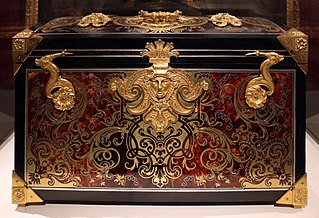
Marquetry is the art and craft of applying pieces of veneer to a structure to form decorative patterns, designs. The technique may be applied to case furniture or even seat furniture, to decorative small objects with smooth, veneerable surfaces or to freestanding pictorial panels appreciated in their own right.

American Empire is a French-inspired Neoclassical style of American furniture and decoration that takes its name and originates from the Empire style introduced during the First French Empire period under Napoleon's rule. It gained its greatest popularity in the U.S. after 1820 and is considered the second, more robust phase of the Neoclassical style, which earlier had been expressed in the Adam style in Britain and Louis Seize, or Louis XVI, in France. As an early-19th-century design movement in the United States, it encompassed architecture, furniture and other decorative arts, as well as the visual arts.
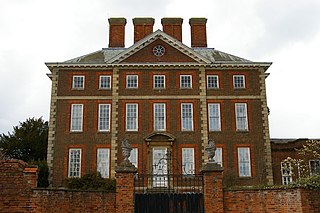
The Queen Anne style of British architecture refers to either the English Baroque architecture of the time of Queen Anne or the British Queen Anne Revival form that became popular during the last quarter of the 19th century and the early decades of the 20th century. In other English-speaking parts of the world, New World Queen Anne Revival architecture embodies entirely different styles.
Chairs are known from Ancient Egypt and have been widespread in the Western world from the Greeks and Romans onwards. They were in common use in China from the twelfth century, and were used by the Aztecs. In Sub-Saharan Africa, chairs were not in use before introduction by Europeans.

A lowboy is an American collectors term for one type of dressing table. It is a small table with one or two rows of drawers, so called in contradistinction to the tallboy or highboy chest of drawers.

Rocaille was a French style of exuberant decoration, with an abundance of curves, counter-curves, undulations and elements modeled on nature, that appeared in furniture and interior decoration during the early reign of Louis XV of France. It was a reaction against the heaviness and formality of the Louis XIV style. It began in about 1710, reached its peak in the 1730s, and came to an end in the late 1750s, replaced by Neoclassicism. It was the beginning of the French Baroque movement in furniture and design, and also marked the beginning of the Rococo movement, which spread to Italy, Bavaria and Austria by the mid-18th century.

A club foot is a type of rounded foot for a piece of furniture, such as the end of a chair leg. It is also known by the alternative names pad foot and Dutch foot, the latter sometimes corrupted into duck foot.

Victorian decorative arts refers to the style of decorative arts during the Victorian era. Victorian design is widely viewed as having indulged in a grand excess of ornament. The Victorian era is known for its interpretation and eclectic revival of historic styles mixed with the introduction of Asian and Middle Eastern influences in furniture, fittings, and interior decoration. The Arts and Crafts movement, the aesthetic movement, Anglo-Japanese style, and Art Nouveau style have their beginnings in the late Victorian era and gothic period.
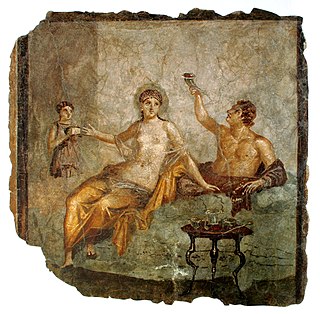
A cabriole leg is one of (usually) four vertical supports of a piece of furniture shaped in two curves; the upper arc is convex, while lower is concave; the upper curve always bows outward, while the lower curve bows inward; with the axes of the two curves in the same plane. This design was used by the ancient Chinese and Greeks, but emerged in Europe in the very early 18th century, when it was incorporated into the more curvilinear styles produced in France, England and Holland.
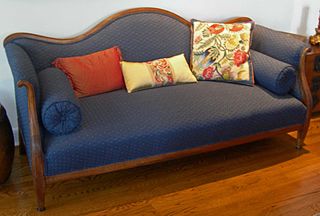
A lyre arm is an element of design in furniture, architecture and the decorative arts, wherein a shape is employed to emulate the geometry of a lyre; the original design of this element is from the Classical Greek period, simply reflecting the stylistic design of the musical instrument. One of the earliest uses extant of the lyre design in the Christian era is a 6th-century AD gravestone with lyre design in double volute form. In a furniture context, the design is often associated with a scrolling effect of the arms of a chair or sofa. The lyre arm design arises in many periods of furniture, including Neoclassical schools and in particular the American Federal Period and the Victorian era. Well known designers who employed this stylistic element include the noted New York City furniture designer Duncan Phyfe.
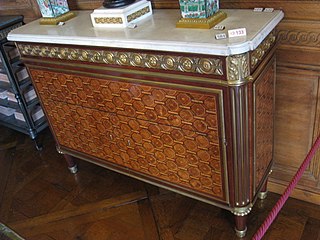
French furniture comprises both the most sophisticated furniture made in Paris for king and court, aristocrats and rich upper bourgeoisie, on the one hand, and French provincial furniture made in the provincial cities and towns many of which, like Lyon and Liège, retained cultural identities distinct from the metropolis. There was also a conservative artisanal rural tradition of French country furniture which remained unbroken until the advent of the railroads in the mid-nineteenth century.

Queen Anne style architecture was one of a number of popular Victorian architectural styles that emerged in the United States during the period from roughly 1880 to 1910. Popular there during this time, it followed the Second Empire and Stick styles and preceded the Richardsonian Romanesque and Shingle styles. Sub-movements of Queen Anne include the Eastlake movement.
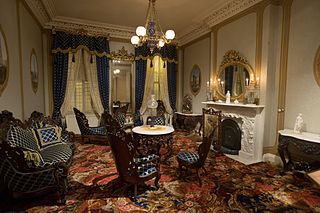
The Rococo Revival style emerged in Second Empire France and then was adapted in England. Revival of the rococo style was seen all throughout Europe during the 19th century within a variety of artistic modes and expression including decorative objects of art, paintings, art prints, furniture, and interior design. In much of Europe and particularly in France, the original rococo was regarded as a national style, and to many, its reemergence recalled national tradition. Rococo revival epitomized grandeur and luxury in European style and was another expression of 19th century romanticism and the growing interest and fascination with natural landscape.

A cabinet is a case or cupboard with shelves and/or drawers for storing or displaying items. Some cabinets are stand alone while others are built in to a wall or are attached to it like a medicine cabinet. Cabinets are typically made of wood, coated steel, or synthetic materials. Commercial grade cabinets usually have a melamine-particleboard substrate and are covered in a high pressure decorative laminate, commonly referred to as Wilsonart or Formica.

This high chest of drawers, also known as a highboy or tallboy, is part of the Decorative Arts collection of the Indianapolis Museum of Art in Indianapolis, Indiana. Made between 1760 and 1780 in Philadelphia, Pennsylvania, its design was inspired by British furniture-maker Thomas Chippendale.

What later came to be known as the William and Mary style is a furniture design common from 1700 to 1725 in the Netherlands, Kingdom of England, Kingdom of Scotland and Kingdom of Ireland, and later in England's American colonies. It was a transitional style between Mannerist furniture and Queen Anne furniture. Sturdy, emphasizing both straight lines and curves, and featuring elaborate carving and woodturning, the style was one of the first to imitate Asian design elements such as japanning.

Louis XIV furniture was massive and lavishly covered with sculpture and ornament of gilded bronze in the earlier part of the personal rule of King Louis XIV of France (1660–1690). After about 1690, thanks in large part to the furniture designer André Charles Boulle, a more original and delicate style appeared, sometimes known as Boulle work. It was based on the use of marquetry, the inlay of piece of ebony and other rare woods, a technique first used in Florence in the 15th century, which was refined and developed by Boulle and others working for the King. Furniture was inlaid with thin plaques of ebony, copper, mother of pearl, and exotic woods of different colors in elaborate designs.

Louis XVI furniture is characterized by elegance and neoclassicism, a return to ancient Greek and Roman models. Much of it was designed and made for Queen Marie Antoinette for the new apartments she created in the Palace of Versailles, Palace of Fontainebleau, the Tuileries Palace, and other royal residences. The finest craftsmen of the time, including Jean-Henri Riesener, Georges Jacob, Martin Carlin, and Jean-François Leleu, were engaged to design and make her furniture.